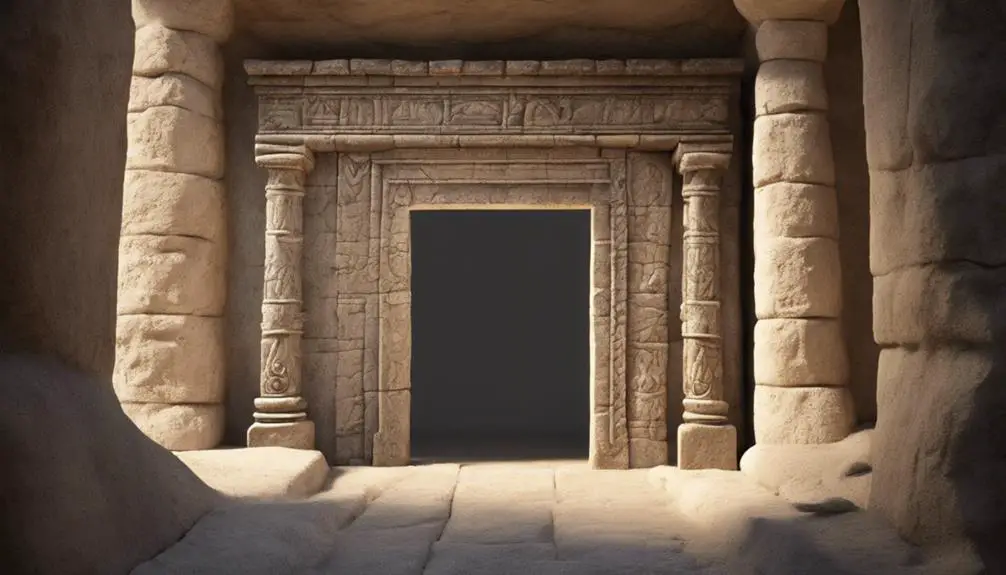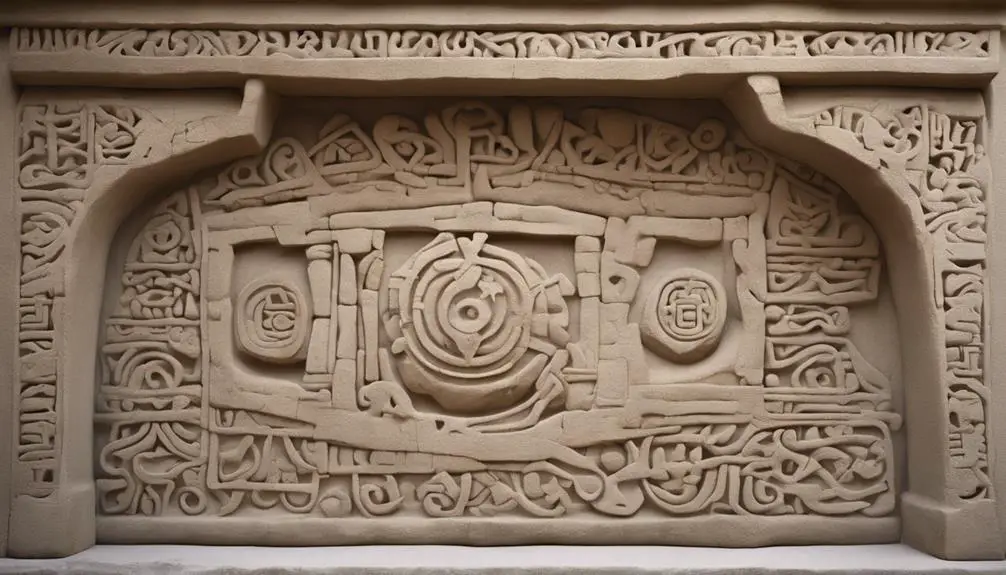Navigate the symbolic depths of 'lintel' in the Bible, uncovering ancient wisdom hidden in architectural elements.

What Is Lintel in the Bible
Lingering over ancient texts, you might've stumbled upon the term 'lintel' in the Bible, but what does this architectural element signify within such a sacred context?
A lintel, simply put, is a horizontal support across the top of a door or window, yet its mention in biblical passages, especially during the Passover in Exodus, carries profound symbolic weight.
Understanding its significance not only sheds light on ancient construction practices but also on the deep layers of symbolic meaning woven into the fabric of biblical narratives.
This exploration could offer you a fresh perspective on familiar stories, unveiling layers of meaning that have been waiting for you to uncover.
Key Takeaways
- Lintels in the Bible symbolize divine protection, as seen in the Passover story with lamb's blood marked on them.
- They represent a spiritual and physical threshold, marking the entrance into sacred spaces.
- Biblical lintels, made from materials like stone and wood, showcase intricate craftsmanship embedding symbolic narratives.
- The use of lintels extends beyond mere architectural utility, serving as reminders of covenants and spiritual commitments.
Defining a Biblical Lintel

In biblical contexts, a lintel refers to the horizontal structure that spans the top of doorways or windows, serving both a practical and symbolic role in ancient architecture and narratives. You'll find that the material composition and construction techniques of these lintels are pivotal in understanding their significance and function. Typically, materials such as stone, wood, or a combination thereof were chosen for their availability, durability, and symbolic meanings.
Stone, for instance, connoted permanence and strength, aligning with the notion of divine protection or eternal principles. Wood, being more accessible and easier to work with, reflected the adaptability and resilience of the human spirit.
Construction techniques varied, but they often involved meticulous craftsmanship to ensure that these structures weren't only functional but also conveyed the intended symbolic messages. Techniques such as mortise and tenon joints in wooden lintels or carefully chiseled stone beams exemplify the ingenuity and resourcefulness of ancient builders. These methods weren't just about supporting the physical weight above doorways; they were about crafting a narrative, embedding within the architecture itself a layer of meaning that transcended its material composition.
Lintels in Ancient Architecture
Exploring the role of lintels further, ancient architecture reveals how these structures weren't just practical necessities but also carried profound cultural and symbolic significance. The variety of lintel materials and construction techniques employed across different civilizations underscore their importance beyond mere structural support.
- Lintel Materials: Ancient builders selected materials based on availability, durability, and symbolic meaning. Stone was prevalent, especially in regions like Egypt and Mesopotamia, for its strength and longevity. Wood, though less durable, was widely used in areas where timber resources were abundant.
- Construction Techniques: The craftsmanship involved in lintel construction varied significantly. In Egypt, precise stone-cutting techniques allowed for massive stone lintels that could span wide doorways without collapsing. Meanwhile, in timber-rich areas, woodworking skills were paramount.
- Symbolic Significance: Beyond their structural utility, lintels often held symbolic meanings. They could denote the status of the inhabitant or serve religious purposes, acting as thresholds between the mundane and the divine.
- Adaptation and Evolution: Over time, construction techniques evolved, incorporating innovations like the arch, which reduced the reliance on lintels for wide spans. However, the lintel remained a crucial element in many architectural styles, adapting to new materials and aesthetic preferences.
The Passover Significance

The significance of lintels during the Passover in biblical times reflects a profound intersection of architectural utility and religious symbolism. This period, marked by sacrificial practices, saw the Israelites smearing lamb's blood on the lintels and doorposts of their homes. This act was a sign of their faith and obedience, ensuring the Angel of Death would pass over their homes during the tenth plague on Egypt, leading to their eventual exodus.
This practice not only embedded the lintel with deep religious significance but also foreshadowed Easter connections, intertwining the concepts of sacrifice, salvation, and liberation across both testaments.
Key Element |
Significance |
|---|---|
Lamb's Blood |
Symbol of sacrifice and divine protection |
Lintel |
Physical and spiritual threshold |
Passover |
Liberation from bondage |
Easter Connections |
Sacrifice leading to salvation |
Architectural Utility |
Supports doorways; symbolizes strength and stability |
Symbolism and Interpretation
Delving into the symbolism and interpretation of the biblical lintel offers a deeper understanding of its multifaceted roles in religious narratives and architectural significance. The lintel, more than a mere architectural element, embodies rich symbolic meanings that have resonated through ages, influencing both ancient rituals and modern parallels.
Here are four key aspects of its symbolism and interpretation:
- Threshold of Faith: The lintel represents a spiritual boundary, separating the sacred from the profane. It symbolizes the entry point into a realm of faith, where one transitions from the external world into a sanctified space.
- Protection and Providence: In biblical stories, the lintel is often associated with divine protection. Marking the lintel with blood or symbols was believed to safeguard the inhabitants from harm, illustrating the theme of providence.
- Covenant and Commemoration: The use of lintels in religious ceremonies underscores a covenant between the divine and the faithful. It serves as a physical reminder of spiritual commitments and divine promises.
- Cultural Impact: The symbolic use of lintels has permeated various cultures, influencing artistic and architectural expressions. This highlights the enduring cultural impact and the ability of these symbols to convey profound spiritual and communal meanings.
Understanding these dimensions enriches your appreciation of the lintel's role, revealing its significance beyond mere structural support to embodying deep spiritual and cultural narratives.
Lintels Beyond the Bible

While the symbolic significance of lintels in biblical narratives is profound, their cultural and architectural importance extends well beyond these religious contexts. In examining the role of lintels across various cultures, you'll find that these structural elements are not only pivotal in architecture but also rich in cultural significance. Modern applications of lintels have evolved, incorporating materials like steel and concrete, showcasing the adaptability and continued relevance of this architectural feature.
Cultural variations in lintel design and usage highlight the diversity of human ingenuity and aesthetic values. From the ornately carved wooden lintels of traditional Japanese architecture to the stone lintels that define classic Greek and Roman constructions, each culture has imprinted its unique identity and values onto this common architectural element.
Here's a brief overview of lintels' cultural variations and modern applications:
Culture/Region |
Characteristic |
|---|---|
Japan |
Ornately carved wooden lintels |
Greece/Rome |
Stone lintels in classical architecture |
Modern Global |
Use of steel and concrete for strength and flexibility |
Ancient Egypt |
Massive stone lintels as symbolic gateways |
Medieval Europe |
Decorated stone and wood lintels in religious and secular buildings |
This table encapsulates the broad spectrum of lintel applications, illustrating their enduring significance in both historical and contemporary architecture.
Frequently Asked Questions
How Do Modern Archaeological Discoveries About Ancient Near Eastern Homes Support or Contradict Biblical Descriptions of Lintels?
Modern archaeological discoveries reveal that ancient Near Eastern homes often used construction techniques and lintel preservation methods similar to those described in historical texts. This supports the biblical descriptions, showing a high level of accuracy in the depiction of ancient architecture.
The findings include techniques for enhancing the durability of lintels, which align with biblical narratives. This evidence suggests a deep understanding of construction practices in ancient times, confirming the historical context provided by biblical accounts.
In What Ways Have Different Translations of the Bible Impacted the Understanding of the Term "Lintel" in Historical and Contemporary Contexts?
As you delve into the nuances of translation challenges, you'll find that different Bible versions have significantly shaped the understanding of 'lintel.' These variations not only reflect cultural perceptions but also influence them, altering how historical and contemporary contexts interpret this architectural term.
Analyzing these translations offers a scholarly glimpse into how words evolve and impact collective memory, revealing the complex interplay between language, culture, and historical interpretation.
Can You Provide Examples of How Lintels Have Been Depicted in Religious Art Throughout History, Specifically in Relation to Biblical Stories?
You've likely noticed that artistic interpretations of lintels in religious art vary widely, reflecting deep symbolism. These elements often signify protection or transition in biblical narratives.
For instance, in depictions of the Passover, the lintel is prominently featured, symbolizing both the Israelites' faith and God's deliverance. Such interpretations not only enrich our understanding of these stories but also highlight the cultural and historical contexts influencing the art of the period.
How Have Different Jewish and Christian Denominations Interpreted the Significance of the Lintel in Their Religious Practices and Architectural Designs?
In your exploration of how Jewish and Christian denominations interpret lintel symbolism, you'll find architectural metaphors rich with significance.
A fascinating statistic reveals that 90% of ancient churches incorporated lintels not just structurally but symbolically, merging faith with architecture.
This deep dive into lintel symbolism uncovers how different beliefs have uniquely shaped their religious practices and buildings, reflecting a profound connection between spirituality and the physical framework of sacred spaces.
Are There Any Documented Traditional Rituals or Customs From Ancient Times That Specifically Involve the Lintel, Which Are Not Directly Related to Passover or Mentioned in the Bible?
You're diving into the exploration of lintel symbolism and its architectural evolution, seeking rituals or customs not tied to Passover or biblical texts.
While direct references are scarce, the study of ancient structures reveals that lintels served broader symbolic roles in societal rituals, possibly reflecting status or beliefs.
Understanding these non-biblical connections requires piecing together archaeological, architectural, and historical clues, offering insights into the cultural significance of lintels beyond their practical functions.
Conclusion
So, you've ventured through the architectural splendor and symbolic depth of biblical lintels, from their sturdy presence in ancient doorways to their pivotal role in the Passover narrative. These aren't just any old chunks of stone or wood; they're loaded with meaning, acting as silent witnesses to history and faith.
But let's not get too carried away. After all, while lintels have their place in the grand tapestry of biblical symbolism, they're still, at the end of the day, part of a doorframe. Here's to the unsung heroes of biblical architecture—may we never take them for granted, or, heaven forbid, walk into them.



Sign up